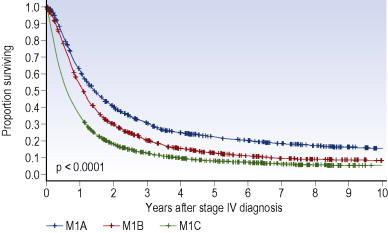Physical Address
304 North Cardinal St.
Dorchester Center, MA 02124
Surgical resection should be considered for all patients with limited numbers of metastatic sites.
Standard cytotoxic chemotherapy has limited efficacy in metastatic melanoma, with response rates in the 10–20% range and short-lived response durations.
High-dose IL-2 is associated with a small percentage of complete and durable responses, but is limited to a subgroup of patients with good performance status owing to its toxicity.
CNS disease is associated with high mortality; surgical resection and stereotactic radiotherapy, if possible, are preferred over whole brain irradiation.
The clinical activity of PLX4032 validates the concept that the BRAF V600E mutation drives melanoma growth and is a therapeutic target in melanoma.
CTLA-4 blockade and specific BRAF inhibition are novel treatment approaches that promise to become standard therapeutic options in the near future.
The tendency for melanoma to spread through the lymphatic system and the bloodstream is in stark contrast to most other skin cancers. Thin melanomas (<1–2 mm) without lymph node involvement is curable in most cases by surgical removal with sufficient margins and adequate staging, which includes assessment of sentinel lymph node involvement if necessary. In contrast, thicker melanomas, ulcerated tumors, or lymph node involvement, although initially mostly amenable to complete surgical resection, confer a much poorer prognosis due to the risk of systemic recurrence, with 5-year survivals ranging from 25% to 75%. Disseminated, locally advanced, or recurrent melanoma is notoriously unresponsive to standard treatment, and is associated with a dismal prognosis, with 5-year survivals of the order of 10–25%.
Advanced melanoma has the highest per-death loss of years of potential life expectancy except for adult leukemia. The incidence of melanoma continues to rise worldwide at approximately 3% per year, and in 2009 there were an estimated 68,720 new cases in the United States and 8650 deaths. According to SEER data, roughly 4% of melanomas are already metastatic at time of diagnosis.
The site of metastatic disease has a direct impact on prognosis and is incorporated within the recent 2009 AJCC staging system, unchanged from 2002. Stage IV melanoma is separated into M1a for skin, soft tissue, or distant lymph node metastases, M1b for pulmonary lesions, and M1c for all other visceral metastases or any distant metastasis with elevated serum LDH levels. Table 57.1 demonstrates the absolute 1-year survival rates of the three M classifications, while Figure 57.1 depicts the relative survival curves generated from the most recent AJCC database.
 |
|
| M0: | no distant metastases |
| M1a: | distant skin, subcutaneous, or nodal metastases with normal serum LDH |
| M1b: | lung metastases with normal serum LDH |
| M1c: | all other visceral metastases with normal serum LDH or any distant metastasis with elevated serum LDH |

Become a Clinical Tree membership for Full access and enjoy Unlimited articles
If you are a member. Log in here